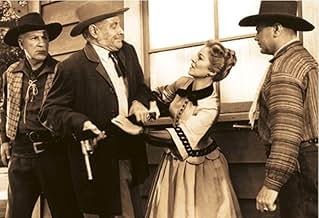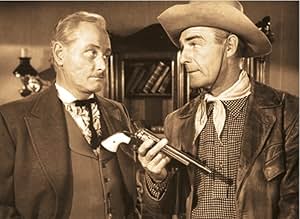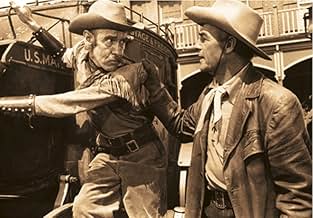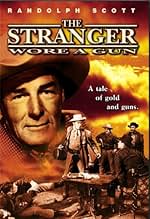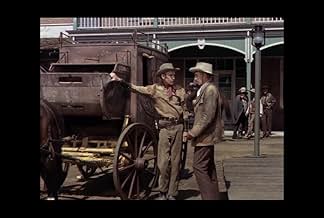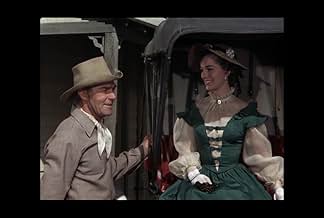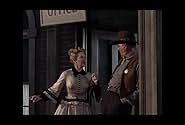CALIFICACIÓN DE IMDb
5.9/10
1.6 k
TU CALIFICACIÓN
Un antiguo espía se traslada a Arizona para participar en un robo de oro, pero cuando llega allí decide que eso no es para él e intenta cambiar de vida.Un antiguo espía se traslada a Arizona para participar en un robo de oro, pero cuando llega allí decide que eso no es para él e intenta cambiar de vida.Un antiguo espía se traslada a Arizona para participar en un robo de oro, pero cuando llega allí decide que eso no es para él e intenta cambiar de vida.
- Dirección
- Guionistas
- Elenco
Victor Adamson
- Barfly
- (sin créditos)
Richard Alexander
- Townsman
- (sin créditos)
Roscoe Ates
- Jake Hooper - Stage Driver
- (sin créditos)
Rayford Barnes
- Raider Todd
- (sin créditos)
- …
Dick Benjamin
- Minor Role
- (sin créditos)
Barry Brooks
- Undetermined Role
- (sin créditos)
George Bruggeman
- Riverboat Passenger
- (sin créditos)
- Dirección
- Guionistas
- Todo el elenco y el equipo
- Producción, taquilla y más en IMDbPro
Opiniones destacadas
Fresh from his work on 'House of Wax' Andre De Toth was assigned another 3D project by Columbia in the form of this Randolph Scott western with rather Gothic-looking interiors in which De Toth demonstrates a liking for shadows when not pushing objects at the audience. These include Lee Marvin, already teamed with Ernest Borgnine, with whom he soon made such an ugly pair of heavies in 'Bad Day at Black Rock' (the two of them vying with Alfonso Bedoya to see who can show the most teeth while grimacing).
There's hardly any romance this time round, Claire Trevor providing wry asides rather than fluttering her eyelashes.
There's hardly any romance this time round, Claire Trevor providing wry asides rather than fluttering her eyelashes.
With Randolph Scott in his best outfit riding his best horse (Starlight) and looking and acting his dusty old best, and with Lee Marvin and Ernest Borgnine at their early villainous peaks, this could have been something. With Andre de Toth directing, it really should have been something. But it's not something. It's not anything, except a mess. Horrendous dialogue, terrible editing (the big gunfight in the mountains is unintelligible until the principals gather to rehash what just happened), and some really bad acting (not so much from Scott, Borgnine, or Marvin, but pretty much everybody else. Alfonso Bedoya is a joy to watch, as always, not because of his acting, which is abominable, but because it's so much fun trying to figure out what it is he's doing with his mouth to make him sound that way. George Macready, who belongs in things like "Gilda" rather than oaters like this, kept getting shoved into Randolph Scott Westerns (four of them). He's incredibly out of place in all of them. And Claire Trevor, so wonderful in "Dead End" and "Key Largo," is wasted here and one's heart goes out to the Oscar-winning actress for having to do such pot-boiling dreck as this a scant five years after winning that Oscar. The attempts at 3-D effects are pretty laughable in their earnestness, and for an action movie, an awful lot of the actual action occurs just off-screen -- saving money on stuntmen and stagecoaches, I suppose, but diluting the feel of the down-and-dirty Western this clearly wants to be taken for. I'll watch anything Randolph Scott did in the Fifties and Sixties, but this one was an absolute chore. I'd sure like to know where to get a coat like that, though.
There are quite a few surprises in this film. First of all, it keeps you guessing especially as regards Randolph Scott's character, whose motivation is difficult to discern. It's hard to tell if he's a bad guy or a good guy sometimes, as he manipulates two different gangs of unsavory characters. This does not anticipate Yojimbo or A Fisftful of Dollars. Both of those films, plus this film, all derive somewhat from The Glass Key, which was filmed twice before The Stranger Wore A Gun was released in 1953. (In 1935 with George Raft and 1942 with Alan Ladd.)Those films were based on Dashiell Hammett's novel of 1931. In any case, this film has its own tale to tell, and the performances of Scott, Lee Marvin and Ernest Borgnine are solid. The film suffers somewhat from the 3-D effects which are kind of lame in the 2-D format we have to suffer on our TV sets. People who don't remember the 3-D craze will probably think the director was weird. All in all, the film's offbeat style and great ensemble cast make this well worth watching a time or two. It is by no means an ordinary run-of-the-mill Western.
I have a feeling that a lot of The Stranger Wore a Gun was left on the cutting room floor and if someone's ever interested in a director's cut it might explain some of the holes in this story.
The film opens in the middle of raid on Lawrence, Kansas by William Quantrill. Disgusted by all the killing, Randolph Scott quits the outfit, but can't outrun his reputation. Going further and further west Scott gets himself involved with another ex-Quantrill man, George MacReady who's looking to set himself up in Arizona as another version of Quantrill.
This is the last of four films Scott made with George MacReady, not counting their joint appearance in Follow the Boys. The first one they did together, Coroner Creek, is a classic among westerns. Sad to say the quality diminished as the two worked together until this one.
I couldn't follow the story nor could see what Scott's motivations were for doing what he did. It might be a case of bad editing or maybe it wasn't that good to begin with. I think it's one of the weaker Randolph Scott westerns.
Claire Trevor is yet again a saloon girl with a heart of gold and a yen for Randolph Scott and her rival is Joan Weldon, stage line owner. Doing almost a dress rehearsal for the parts they did in Bad Day at Black Rock are future Oscar winners Ernest Borgnine and Lee Marvin as a pair of MacReady gang members.
I will say if you can sit and sift through the plot you will not be disappointed in the shootout between Scott and MacReady inside a burning saloon. Would that the rest of the film was as good.
The film opens in the middle of raid on Lawrence, Kansas by William Quantrill. Disgusted by all the killing, Randolph Scott quits the outfit, but can't outrun his reputation. Going further and further west Scott gets himself involved with another ex-Quantrill man, George MacReady who's looking to set himself up in Arizona as another version of Quantrill.
This is the last of four films Scott made with George MacReady, not counting their joint appearance in Follow the Boys. The first one they did together, Coroner Creek, is a classic among westerns. Sad to say the quality diminished as the two worked together until this one.
I couldn't follow the story nor could see what Scott's motivations were for doing what he did. It might be a case of bad editing or maybe it wasn't that good to begin with. I think it's one of the weaker Randolph Scott westerns.
Claire Trevor is yet again a saloon girl with a heart of gold and a yen for Randolph Scott and her rival is Joan Weldon, stage line owner. Doing almost a dress rehearsal for the parts they did in Bad Day at Black Rock are future Oscar winners Ernest Borgnine and Lee Marvin as a pair of MacReady gang members.
I will say if you can sit and sift through the plot you will not be disappointed in the shootout between Scott and MacReady inside a burning saloon. Would that the rest of the film was as good.
The location shooting was done at Movie Flats off Route 395 near Lone Pine, California, and, along with a lot of faces in this film, will be familiar to experienced moviegoers. They've been making movies up there for years. The rocks themselves are studded with bolts and adhesions of cement left over from early productions, which date back at least to "Gunga Din." And it's easy to see why it was used so often in inexpensive Westerns like this. The jumbo-sized boulders seem made of stucco and the Sierra Nevadas in the background include Mt. Whitney, as colorful as a painted backdrop. The whole place looks as if nature had put it there to be used as a spectacularly realistic phony movie set.
Yes, it's alive with history. The ghosts of a thousand extras in sombreros haunt these rugged trails, and at night when the wind moans you can hear the hoofbeats of yesteryear. Zzzzz.
Some of the ghosts must surely include Randolph Scott, who spent so much time before the cameras here in so many movies. In this one, he's an ex-confederate who allows himself to be hired out to save a stagecoach company that ships gold to -- well, never mind.
Scott is in his burnished Western middle age and rides his usual horse, a beautiful mount, a kind of rusty brown animal with a white face, white maine, and white tail. (I was momentarily tempted to call the horse a "roan" but hesitated to do so because I don't know what the word means.) Anyway, the horse will be almost as familiar as Scott. Scott's hat will look familiar too. So will Ernest Borgnine and Lee Marvin, the two outstanding heels of "Bad Day at Black Rock," but they don't get enough screen time. Alfonso Bedoya, Gold Hat from "The Treasure of the Sierra Madre," has more screen time. He can't act, but he doesn't have to. If you think he did curious things to the word "badges" in "Treasure," you absolutely must hear how he wraps his speech organs around "foreigner" in this one. George MacReady is the chief villain. I prefer it when his villainy is of a slyer, more boardroom-bound sort.
Claire Trevor is a hooker with a heart of gold. I know it's hard to believe, but hookers come in all different varieties. Joan Weldon is pretty and was a singer rather than an actress. There is a marvelous scene in which Scott introduces his old girl friend, Trevor, to Weldon, the new young beauty he's just met, and the two women trade the kind of insults and suspicious queries that only women know how to sling about. "It's funny he never mentioned you to me." And, "From the way he described you, I thought you'd be much older." Scott, meanwhile, is standing there with this dumb smile, looking back and forth at his two friends, as if pleased that they are being so nice to one another, giving an excellent impression of a man who hasn't the slightest idea of what's going on between them.
Movies like this don't crop up on TV very often and sometimes, remembering how much I enjoyed them as a child, I find myself missing them. Then sometimes they DO show up, as this one did, and I watch it out of curiosity and wind up realizing that there are a lot of things to be nostalgic about but Westerns like this aren't among them.
Yes, it's alive with history. The ghosts of a thousand extras in sombreros haunt these rugged trails, and at night when the wind moans you can hear the hoofbeats of yesteryear. Zzzzz.
Some of the ghosts must surely include Randolph Scott, who spent so much time before the cameras here in so many movies. In this one, he's an ex-confederate who allows himself to be hired out to save a stagecoach company that ships gold to -- well, never mind.
Scott is in his burnished Western middle age and rides his usual horse, a beautiful mount, a kind of rusty brown animal with a white face, white maine, and white tail. (I was momentarily tempted to call the horse a "roan" but hesitated to do so because I don't know what the word means.) Anyway, the horse will be almost as familiar as Scott. Scott's hat will look familiar too. So will Ernest Borgnine and Lee Marvin, the two outstanding heels of "Bad Day at Black Rock," but they don't get enough screen time. Alfonso Bedoya, Gold Hat from "The Treasure of the Sierra Madre," has more screen time. He can't act, but he doesn't have to. If you think he did curious things to the word "badges" in "Treasure," you absolutely must hear how he wraps his speech organs around "foreigner" in this one. George MacReady is the chief villain. I prefer it when his villainy is of a slyer, more boardroom-bound sort.
Claire Trevor is a hooker with a heart of gold. I know it's hard to believe, but hookers come in all different varieties. Joan Weldon is pretty and was a singer rather than an actress. There is a marvelous scene in which Scott introduces his old girl friend, Trevor, to Weldon, the new young beauty he's just met, and the two women trade the kind of insults and suspicious queries that only women know how to sling about. "It's funny he never mentioned you to me." And, "From the way he described you, I thought you'd be much older." Scott, meanwhile, is standing there with this dumb smile, looking back and forth at his two friends, as if pleased that they are being so nice to one another, giving an excellent impression of a man who hasn't the slightest idea of what's going on between them.
Movies like this don't crop up on TV very often and sometimes, remembering how much I enjoyed them as a child, I find myself missing them. Then sometimes they DO show up, as this one did, and I watch it out of curiosity and wind up realizing that there are a lot of things to be nostalgic about but Westerns like this aren't among them.
¿Sabías que…?
- TriviaAlthough the film was another 3-D film by director Andre De Toth, he only had one eye and would never be able to see the result of the process. The other 3-D film he directed was "House of Wax."
- ErroresColt 1873 revolvers were used but the Civil War ended before those revolvers were developed.
- Citas
Jeff Travis: A man's only as good as his cards.
- ConexionesReferenced in The Fifties (1997)
Selecciones populares
Inicia sesión para calificar y agrega a la lista de videos para obtener recomendaciones personalizadas
- How long is The Stranger Wore a Gun?Con tecnología de Alexa
Detalles
Taquilla
- Total en EE. UU. y Canadá
- USD 1,600,000
- Tiempo de ejecución
- 1h 23min(83 min)
Contribuir a esta página
Sugiere una edición o agrega el contenido que falta


